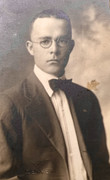I do sloppy family history research in starts and spurts, scribbling nearly indecipherable notes on 3X5 cards and which will make no sense to my survivors, should they even be vaguely interested.
When you do some of this searching, it becomes immediately apparent how perishable a species we are -- and how much more fragile are the traces we leave behind. I doubt there is a human who ever lived to whom the thought did not occur that "gee I wish I had asked grandma more about that ..."
It was in this frame of mind on the recent Memorial Day thinking back on war casualties in my family that memories of my Mom's mom bubbled to the surface, and I remember her sitting on the couch in her apartment in Medford, Oregon, 50 years ago and mentioning that her favorite brother (of the four she had) had died as a result of wounds suffered in World War I.
I dug out some old family photos, and there he was, Earl Dewitt Traylor, a handsome young man, reserved, with a kind face. And there was another grainy photo of him in his wrinkled Doughboy's uniform, 1911 holstered at his side, his fists clinched in standing at attention, but with a look in his eyes that seems to say, "I have seen things ... horrible things." My grandmother had written on the back: "Died November 3, 1920," of war injuries. A young man now gone for more than a century, dying without issue -- I wanted to know more.
Google and the Internet have been inestimable gifts to genealogists. It did not take long to find his grave at Fairmount Cemetery in Denver using the Find-a-Grave search engine. Toggling from there to Familysearch.org I was able to pull up more traces, census mentions, (He was born in Abilene) and a file card kept by the Veterans Administration that gave valuable details: Uncle Earl's serial number, and the unit he served in -- Company A of the 342nd Machine Gun Battalion, 89th Division, American Expeditionary Forces.
And when I typed in the unit information and ran a search, lo and behold, up came the official company history in its entirety on the Missouri Secretary of State's site in the Missouri Digital History Collection. I couldn't believe my good fortune, and as I read further, a mystery was solved. In the photo of Uncle Earl in uniform, there seemed to be what I thought was an imperfection in the print appearing as a dark spot on his left cheek.
The company history says the unit's baptism of fire came on August 7th, 1918, when the 342nd was tasked to relieve another machine gun battalion in front-line trenches near Xivray and Seichesprey, France. The first night, at 2 a.m., they took a tremendous pounding from German mustard gas shells, with many of Company A badly burned; Uncle Earl's gas wounds apparently were less serious, but that "imperfection" in his photo is exactly what a mustard gas burn looks like -- a large, puffy blister filled with liquid just under the skin. So the photo was most likely taken later in August of 1918 somewhere southeast of Verdun in northeastern France.
The 89th was reassigned relief duty around the region and saw 32 straight days of frontline duty and twenty days of heavy fighting in the final push of the war. On the night of November 10th, the battalion was unloading supplies to support two Marine battalions when they took heavy shelling about 9:30 p.m. Among the casualties was PFC Earl D. Traylor. He was finally discharged on June 12, 1919.
I am going through the hoops required by the state of Colorado to obtain a copy of his death certificate.
Even with this information, I still have but a faint sketch of the life of Uncle Earl -- and of the sacrifice he made of his youth, his innocence and his life in service to his country. No one really cares except for me, my brothers and my surviving cousins.
Somehow I find that reason enough to have made the effort. To be able to say, Uncle Earl, you are not forgotten.
His grave marker of pink granite in Denver simply says "Earl D. Traylor, 1896-1920, a soldier." We are going to see if the VA will replace the marker with the standard white marble headstone issued for the graves of all servicemen and women, with Uncle Earl's dates and the unit he served in. To me, a soldier deserves no less.


